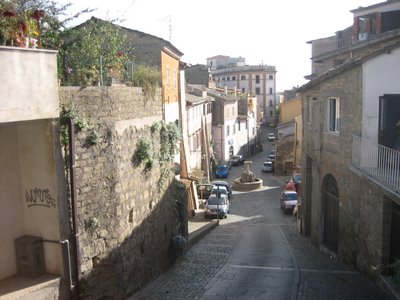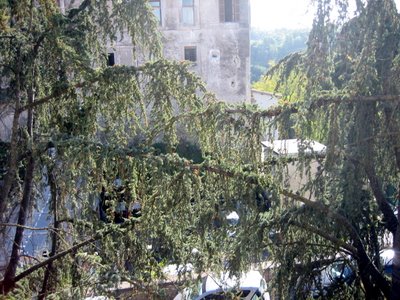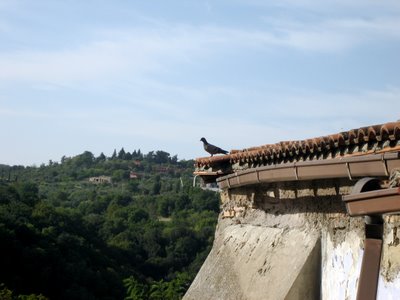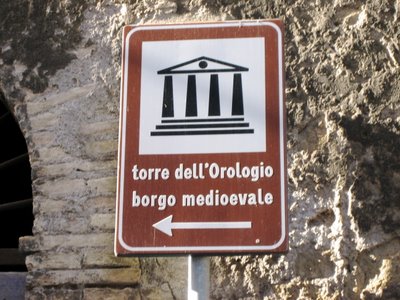three years there is a boat, anchored just after the bridge on the left bank Marconi, who on behalf of the City of Rome, allows those who wish to admire the landscape of both sides of the river, navigating the Bridge Marconi to the excavations of Ostia Antica. The trip is combined with the visit of the excavations can be done for about two hours. After you return the same boat. In return trip I took many photos, of which I offer below a selection. I am unable to give a comment for each picture, but I do not think there is a need as most of nature photos. People living in cities often loses the knowledge and familiarity with nature. I preferred the pictures that give the impression of a more direct contact with nature, not polluted by human actions and presence. Add, finally, that the Tiber was the pre-Christian religious divine place, the seat of a god, not even the river itself was a God Today it is a drain, a filthy place where it is not prudent to eat fish and river fish. I have seen gigantic fish emerge from the water, that I was able to photograph. They were of carp that can weigh twenty pounds or more (words of the captain). Dare to eat them, if they can fish, only the immigrants, who evidently can not afford a diet more hygienically controlled. Along the Tiber, you can see fishing boat, whose fish but I have not accepted once I was offered.
provide the following below each image to mo 'illustration of a text composed of a translation from German by me made to the 1973, while I was studying German at the Faculty of Political Science. I do not know track down the author and the book or the encyclopedia from which it was derived. A translation was requested by me to pay a graduate student in literature. I found the text interesting and I kept a copy of the work done, unfortunately, without having noted the source, who did not believe I was not even mentioned. Unfortunately I miss the Greek fonts.
1.

river god
Rivers according to Homer (Il. 21, 196) all derive originally from Ocean,
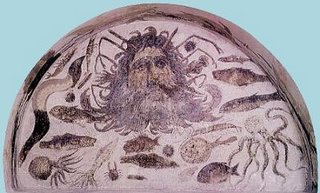
but because people are not all generated by the same, since the Xanthus (Il. 14, 434) is indicated as the son of Zeus. They are often attributed to the deitrefés, diepetés, indicating Zeus in the cause of all the water that falls from the sky. They are immortal like all the other gods (Il. 21, 380), as these have human form, are part of the Plenary Assembly of the Gods (20, 7) come into play as fathers, and in the case of rivers flow into Trojans as essential participants in the action. Even if you own the most powerful among them, Achelous and ocean, do not dare to compete with Zeus (21, 194), however, have an important worship, particularly as reflected by the oath of Agamemnon (Il. 3, 276), next to Earth where they are invoked as a representative of the central territory (see also the oath of the city of Crete in Drero Cauer delectus INSC. nr. 38).
2.

The Scamander, a Mégas Theos, has a priest (aretés, IL 5.78), the Spercheio a temenos and Bwmós; these the Achilles son of Peleus promised the crown and a massacre, and the oath of Odysseus River Scheria (polúllistos, Od. 5, 445) is also the personal cult of the rivers are not important.

In Hesiod. Theog. 337 ff. 367 ff. (See Akusilaos in Macrob. Sat. 5, 18, 10) the rivers are the sons of Oceanus and Tethys, three thousand in number, which is flanked by many sources as sisters. Their power can not be crossed without having made a prayer and with unclean hands, Hes. Opp. 737 ff.
3.

Together with Apollo and take care of the rivers feeding the young, which consecrates them so the hair. This can be deduced allorhé rivers such deities are invoked to procure the removal of the disease and healing, like the Apples in Izmir, Imera in Sicily (CIG 3165, 5747), the latter under the title of swtér, and as well as a tributary of Strymen Herod, 8, 138.
4.

To Because of this their pedagogical function rivers are often the most ancient principles of a country, the founders of their culture, the ancestors of the less noble (Preller, Gr Myth. / 3, I, 447). They were therefore represented as old men with the insignia of princely dignity. Ismenos appears on a vase next to Asti Cdmo fighting with the dragon (Millingen, anc. Starvation. Monum. I, 27. Welcker, Alte Denk. 3, 23 ff), visible to the base of the chest with a scepter in his hand . Same for Asopos on a vessel of Vulcan (inschr.) which represents the pursuit of Aegina, Braun, ant. Marble. I, 6. Mus. Greg. 2, 20, I Jahn, architect. Beitr. 31. It is likely that the votive offering of Asopus Phliasier (Paus. 5, 22, 6) was shown in a similar way.
5.

rivers often appear in the legends of erotic content, cf. Alpheios, Akis, Enipeus, Spercheios, STRIMON. The struggle with Herakles Achelous is the defense of a violent suitor Deianeira. The more the river gods show themselves capable of changing their shape (Nereus, Proteus, Thetis), the more data processing include legends about rivers (Acheloos, Krimisos). Numerous legends have been passed mainly by Pseudo-Plutarch, that a river is named after a man who died in its waters, or near, the whole show source most recent inventions and are often aware of same authors (de Plut. Fluvià. Hercher and, Praef. p. 28 ff.).
6.

RIVERS IN THE FORM OF WORSHIP IN POETRY AND ART
The news Aelian. var. hist. 2.33 gives the formation of river gods often, as will become, inaccurate and erroneous. It has been said that Homer in the rivers have always human form, the representation in the form of bull is unknown. This human form but is not the personification of a place, but distinctly mythological individuality, which at that time no child of reflection is identified with the natural shape of rivers. Such a divine individuality show the most ancient representations plastics of river gods that are left, that the rivers on the pediment of the Temple of Zeus at Olympia

and that of the Parthenon. The artist put the figure lying in the corners of the pediment, not so much to show that the struggle with the battle between Pelops and Oinomaos take place within and between Alfeos Cladeos, or that the dispute between Athena and Poseidon took place on the banks of Cephisus, how to represent people who are truly divine in the role of spectators who share leaked their enthusiastic interest in the outcome of the struggle. Lying for a long time, as befits a deity of the place that are nailed to the ground, they remain there still. Alpheus at Olympia in the left corner, the largest and therefore the most oldest of two, appears with a bearded face, looking with deep sympathy toward the center. The young Kladeos in the right, lying on his stomach in a natural position rather coarse, follows with keen participation in the events at the center, the right forearm is raised with expressive gesture. In both the figue had no detectable trace of that fantastic feeling of nattura, who lives at a later date in the form of gently reclining river gods (see Archäol. Tg. 1879, p. 119, 1882, p. 224. Gerber, Jahrb. f. Phil. Suppl. 13, p. 277).
7.

8.

9.

10.

11.

12.

13.

14.

15.

16.


















